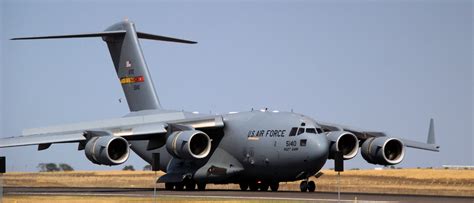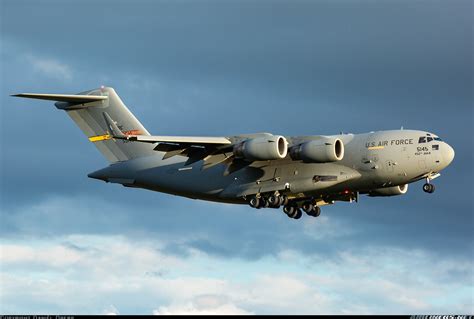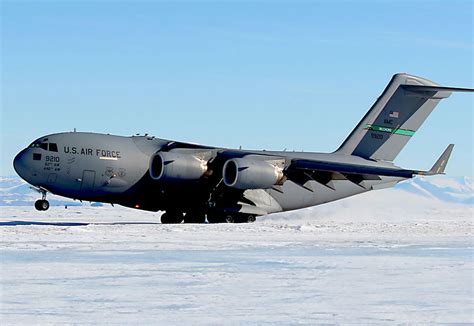The Boeing C-17 Globemaster III is a large military transport aircraft that has been a cornerstone of strategic airlift capabilities for the United States Air Force and several other nations since its introduction in the late 1990s. With its distinctive high-wing design, four-engine configuration, and rear-loading ramp, the C-17 has proven itself to be an indispensable asset for military logistics, humanitarian missions, and disaster relief efforts. The development of the C-17 Globemaster design is a testament to the integration of advanced technology, innovative design principles, and the evolving needs of modern military operations.
Key Points
- The C-17 Globemaster III features a high-wing design, enhancing its cargo capacity and maneuverability.
- Its four-engine configuration, utilizing Pratt & Whitney F117-PW-100 turbofan engines, provides a significant increase in power and efficiency.
- The aircraft's rear-loading ramp and door system enables rapid deployment of troops, vehicles, and cargo.
- The C-17 has a maximum takeoff weight of approximately 585,000 pounds and can carry payloads of up to 170,900 pounds.
- Advanced avionics and fly-by-wire systems contribute to the aircraft's reliability, safety, and reduced crew workload.
Design Evolution and Technical Specifications

The design of the C-17 Globemaster III was the result of a collaborative effort between Boeing (then McDonnell Douglas) and the U.S. Air Force, aimed at replacing the aging C-141 Starlifter. The program was initiated in the 1980s, with the first C-17 making its maiden flight in 1991. The aircraft’s design philosophy emphasized versatility, efficiency, and the ability to operate from austere airfields, reflecting the changing nature of military conflicts and the need for rapid, global deployment capabilities.
Aerodynamic and Structural Innovations
The C-17’s aerodynamic design incorporates a number of innovative features, including its high-wing configuration, which provides enhanced stability and allows for a larger cargo bay. The aircraft’s wings are also equipped with advanced high-lift devices, enabling it to operate from short and unprepared runways. Structurally, the C-17 is built around a robust airframe designed to withstand the rigors of frequent takeoffs, landings, and the potential for exposure to hostile environments.
| Technical Specification | Value |
|---|---|
| Length | 174 feet (53 meters) |
| Wingspan | 169.8 feet (51.75 meters) |
| Height | 55.1 feet (16.8 meters) |
| Maximum Takeoff Weight | 585,000 pounds (265,352 kilograms) |
| Range | 2,400 nautical miles (4,444 kilometers) with 170,900 pounds (77,519 kilograms) payload |

Operational Capabilities and Strategic Implications

The C-17 Globemaster III has demonstrated its operational capabilities in various theaters around the world, from the deserts of the Middle East to the mountains of Afghanistan. Its ability to transport large payloads over long distances, combined with its capacity for rapid deployment and extraction of troops and equipment, has made it an indispensable asset for military commanders. The aircraft’s performance in humanitarian missions, such as disaster relief and evacuation operations, further highlights its value beyond traditional military roles.
Future Developments and Upgrades
As military aviation continues to evolve, the C-17 Globemaster III is expected to undergo future upgrades and modernizations to maintain its effectiveness. These may include advancements in avionics, propulsion systems, and materials, aimed at enhancing the aircraft’s efficiency, safety, and operational capabilities. The integration of emerging technologies, such as autonomous systems and advanced sensors, could also play a role in the C-17’s future development, potentially expanding its mission envelope and contributing to the next generation of strategic airlift capabilities.
What is the primary role of the C-17 Globemaster III in military operations?
+The primary role of the C-17 Globemaster III is strategic airlift, providing the capability to transport large payloads of troops, equipment, and supplies over long distances, supporting a wide range of military operations.
How does the C-17's design contribute to its operational versatility?
+The C-17's high-wing design, four-engine configuration, and rear-loading ramp contribute to its operational versatility, enabling it to carry out missions ranging from strategic airlift to tactical airlift and airdrop, in diverse and challenging environments.
What are the implications of the C-17 Globemaster III's capabilities for future military aviation developments?
+The C-17 Globemaster III's capabilities underscore the importance of adaptable design, advanced technology integration, and operational flexibility in future military aircraft developments. Its performance sets a high standard for next-generation strategic airlift capabilities, emphasizing the need for aircraft that can operate effectively in a rapidly changing global environment.
In conclusion, the Boeing C-17 Globemaster III represents a pinnacle of strategic airlift capability, combining advanced design, technological innovation, and operational versatility to meet the evolving needs of modern military operations. As the global security landscape continues to shift, the C-17’s role in supporting military, humanitarian, and disaster relief efforts will remain critical, serving as a testament to the enduring importance of adaptable and effective airpower.



